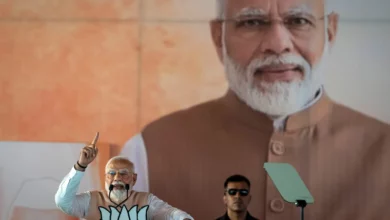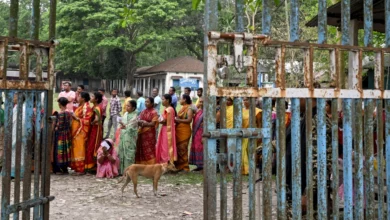
Chandrayaan, which means “moon vehicle” in Sanskrit, is expected to take off from the Satish Dhawan Space Center at Sriharikota in southern Andhra Pradesh state at 2:30 p.m. local time (5 a.m. ET).
It’s India’s second attempt at a soft landing, after its previous effort with the Chandrayaan-2 in 2019 failed. Its first lunar probe, the Chandrayaan-1, orbited the moon and was then deliberately crash-landed onto the lunar surface in 2008.
Developed by the Indian Space Research Organization (ISRO), Chandrayaan-3 is comprised of a lander, propulsion module and rover. Its aim is to safely land on the lunar surface, collect data and conduct a series of scientific experiments to learn more about the moon’s composition.
Only three other countries have achieved the complicated feat of soft-landing a spacecraft on the moon’s surface – the United States, Russia and China.
Indian engineers have been working on the launch for years. They are aiming to land Chandrayaan-3 near the challenging terrain of the moon’s unexplored South Pole.
India’s maiden lunar mission, Chandrayaan-1, discovered water molecules on the moon’s surface. Eleven years later, the Chandrayaan-2 successfully entered lunar orbit but its rover crash-landed on the moon’s surface. It too was supposed to explore the moon’s South Pole.
At the time, Indian Prime Minister Narendra Modi hailed the engineers behind the mission despite the failure, promising to keep working on India’s space program and ambitions.
Just before Friday’s launch, Modi said the day “will always be etched in golden letters as far as India’s space sector is concerned.”
“This remarkable mission will carry the hopes and dreams of our nation,” he said in a Twitter post.
India has since spent about $75 million on its Chandrayaan-3 mission.
Modi said the rocket will cover more than 300,000 kilometers (186,411 miles) and reach the moon in the “coming weeks.”
Decades in the making
India’s space program dates back more than six decades, to when it was a newly independent republic and a deeply poor country reeling from a bloody partition.
When it launched its first rocket into space in 1963, the country was no match for the ambitions of the US and the former Soviet Union, which were way ahead in the space race.
Now, India is the world’s most populous nation and its fifth largest economy. It boasts a burgeoning young population and is home to a growing hub of innovation and technology.
And India’s space ambitions have been playing catch up under Modi.
For the leader, who swept to power in 2014 on a ticket of nationalism and future greatness, India’s space program is a symbol of the country’s rising prominence on the global stage.
In 2014, India became the first Asian nation to reach Mars, when it put the Mangalyaan probe into orbit around the Red Planet, for $74 million – less than the $100 million Hollywood spent making space thriller “Gravity.”
Three years later, India launched a record 104 satellites in one mission.
In 2019, Modi announced in a rare televised address that India had shot down one of its own satellites, in what it claimed was an anti-satellite test, making it one of only four countries to do so.
That same year ISRO’s former chairman Kailasavadivoo Sivan said India was planning to set up an independent space station by 2030. Currently, the only space stations available for expedition crews are the International Space Station (a joint project between several countries) and China’s Tiangong Space Station.
The rapid development and innovation has made space tech one of India’s hottest sectors for investors – and world leaders appear to have taken notice.
Last month, when Modi met US President Joe Biden in Washington on a state visit, the White House said both leaders sought more collaboration in the space economy.
And India’s space ambitions do not stop at the moon or Mars. ISRO has also proposed sending an orbiter to Venus.



